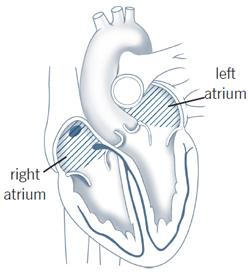

© All rights reserved galwayclinic.com 2013

Signs and Symptoms
A heart that beats too fast or too slow can cause: • Lightheadedness or dizziness • Palpitations (skipping, fluttering or pounding in the chest) • Fatigue • Chest pressure or pain • Shortness of breath • Fainting spells On one hand, some arrhythmias are common, so-called benign arrhythmias. that have no severe symptoms. One of the goals of evaluation is to sort out the serious from benign forms of heart beat disturbances. An abnormal heart rhythm is a change in either the speed or the pattern of the heartbeat — the heart may beat too slowly, too rapidly or irregularly. When the heart beats too slowly, too little blood is pumped out to the rest of the body. When the heart beats too quickly, it cannot fill completely so the body doesn't receive the blood volume it needs to function properly. Slow heart rates are called bradycardias. Fast heart rates are called tachycardias. The heart is made up of four chambers. The upper chambers, called the atria, receive and collect blood. The lower chambers, called the ventricles, pump blood to the body. Working together, the chambers of the heart move life-sustaining blood throughout the body. There are several types of abnormal heart rhythms, some occur in one of the atria and are called atrial, others occur in the ventricles and are called ventricular in origin.Supraventricular tachycardia
Supraventricular tachycardia

Supraventricular arrhythmias begin in
the atria
• These are arrhythmias that begin above the ventricles. • "Supra" means above and "ventricular" refers to the lower chambers of the heart (ventricles). • Paroxysmal supraventricular tachycardia (PSVT): A rapid but regular heart rhythm that comes from the atria. This type of arrhythmia begins and ends suddenly. It can last for seconds or many minutes at a time. • Accessory pathway tachycardias (such as Wolff- Parkinson-White syndrome): A fast heart rhythm caused by an extra, abnormal electrical pathway or connection between the atria and ventricles. The impulses travel through the extra pathways as well as the usual route. This allows the impulses to travel around the heart very quickly, causing the heart to beat unusually fast. • AV nodal re-entrant tachycardia (AVNRT): A fast heart rhythm caused by the presence of more than one pathway through the atrioventricular (AV) node. • Atrial tachycardia: A rapid heart rhythm that originates in the atria. • Atrial fibrillation: A very common irregular heart rhythm. Many impulses coming from the pulmonary veins spreading through the atria and down to the ventricles. The resulting rhythm is disorganized, rapid and irregular. Because the impulses are traveling through the atria in a disorderly fashion, there is a loss of coordinated atrial contraction. • Atrial flutter: An atrial arrhythmia caused by one or more rapid circuits in the atrium. Atrial flutter is usually more organized and regular than atrial fibrillation.Types of Ventricular Arrhythmias
A ventricular arrhythmia begins in the heart’s ventricles.
•
Premature ventricular contractions (PVCs): Early, extra
heartbeats that originate in the ventricles. Most of the time, PVCs
don’t cause any symptoms or require treatment. This type of
arrhythmia is common and can be related to stress, too much
caffeine or nicotine, or exercise. They can be also be caused by
heart disease or electrolyte imbalance. People who have several
PVCs and/or symptoms associated with them should be evaluated
by a cardiologist .
•
Ventricular tachycardia (V-tach): A rapid heartbeat that
originates in the ventricles. The rapid rhythm keeps the heart from
adequately filling with blood, and less blood is able to pump
through the body. This rhythm can be serious, especially in people
with heart disease or a prior heart attack. A second form of this
tachycardia can occur in people with entirely normal hearts and
causes palpitations with exercise. This idiopathic ventricular
tachycardia is very amenable to cure by ablation. This form is due
to a focus of automatic tissue in the ventricle or pulmonary artery
•
Ventricular fibrillation (V-fib): An erratic, disorganized
firing of impulses from the ventricles. The ventricles quiver and
cannot generate an effective contraction, which results in a lack of
blood being delivered to the body. This is a medical emergency
that must be treated with cardiopulmonary resuscitation (CPR)
and defibrillation (delivery of an energy shock to the heart muscle
to restore a normal rhythm) as soon as possible. This is usually
only seen in the setting of an acute heart attack or sudden cardiac
death.
How is an arrhythmia diagnosed?
If you have symptoms of an arrhythmia, you should make an appointment with a cardiologist or an electrophysiologist — a cardiologist who has several years of additional specialized training in the diagnosis and treatment of heart rhythm disorders. After evaluating your symptoms and performing a physical examination, the cardiologist may perform a variety of diagnostic tests to help confirm the presence of an arrhythmia and indicate its causes.
Galway Clinic Facebook page
Tel: +353 (0) 91720170 brendan.ocochlain@galwayclinic.com


Galway Site Design

Signs and Symptoms
A heart that beats too fast or too slow can cause: • Lightheadedness or dizziness • Palpitations (skipping, fluttering or pounding in the chest) • Fatigue • Chest pressure or pain • Shortness of breath • Fainting spells On one hand, some arrhythmias are common, so-called benign arrhythmias. that have no severe symptoms. One of the goals of evaluation is to sort out the serious from benign forms of heart beat disturbances. An abnormal heart rhythm is a change in either the speed or the pattern of the heartbeat — the heart may beat too slowly, too rapidly or irregularly. When the heart beats too slowly, too little blood is pumped out to the rest of the body. When the heart beats too quickly, it cannot fill completely so the body doesn't receive the blood volume it needs to function properly. Slow heart rates are called bradycardias. Fast heart rates are called tachycardias. The heart is made up of four chambers. The upper chambers, called the atria, receive and collect blood. The lower chambers, called the ventricles, pump blood to the body. Working together, the chambers of the heart move life-sustaining blood throughout the body. There are several types of abnormal heart rhythms, some occur in one of the atria and are called atrial, others occur in the ventricles and are called ventricular in origin.Supraventricular tachycardia
Supraventricular tachycardia

Supraventricular arrhythmias begin in the atria
• These are arrhythmias that begin above the ventricles. • "Supra" means above and "ventricular" refers to the lower chambers of the heart (ventricles). • Paroxysmal supraventricular tachycardia (PSVT): A rapid but regular heart rhythm that comes from the atria. This type of arrhythmia begins and ends suddenly. It can last for seconds or many minutes at a time. • Accessory pathway tachycardias (such as Wolff- Parkinson-White syndrome): A fast heart rhythm caused by an extra, abnormal electrical pathway or connection between the atria and ventricles. The impulses travel through the extra pathways as well as the usual route. This allows the impulses to travel around the heart very quickly, causing the heart to beat unusually fast. • AV nodal re-entrant tachycardia (AVNRT): A fast heart rhythm caused by the presence of more than one pathway through the atrioventricular (AV) node. • Atrial tachycardia: A rapid heart rhythm that originates in the atria. • Atrial fibrillation: A very common irregular heart rhythm. Many impulses coming from the pulmonary veins spreading through the atria and down to the ventricles. The resulting rhythm is disorganized, rapid and irregular. Because the impulses are traveling through the atria in a disorderly fashion, there is a loss of coordinated atrial contraction. • Atrial flutter: An atrial arrhythmia caused by one or more rapid circuits in the atrium. Atrial flutter is usually more organized and regular than atrial fibrillation.Types of Ventricular Arrhythmias
A ventricular arrhythmia begins in the heart’s ventricles.
•
Premature ventricular contractions (PVCs): Early, extra
heartbeats that originate in the ventricles. Most of the time, PVCs
don’t cause any symptoms or require treatment. This type of
arrhythmia is common and can be related to stress, too much
caffeine or nicotine, or exercise. They can be also be caused by
heart disease or electrolyte imbalance. People who have several
PVCs and/or symptoms associated with them should be evaluated
by a cardiologist .
•
Ventricular tachycardia (V-tach): A rapid heartbeat that
originates in the ventricles. The rapid rhythm keeps the heart from
adequately filling with blood, and less blood is able to pump
through the body. This rhythm can be serious, especially in people
with heart disease or a prior heart attack. A second form of this
tachycardia can occur in people with entirely normal hearts and
causes palpitations with exercise. This idiopathic ventricular
tachycardia is very amenable to cure by ablation. This form is due
to a focus of automatic tissue in the ventricle or pulmonary artery
•
Ventricular fibrillation (V-fib): An erratic, disorganized
firing of impulses from the ventricles. The ventricles quiver and
cannot generate an effective contraction, which results in a lack of
blood being delivered to the body. This is a medical emergency
that must be treated with cardiopulmonary resuscitation (CPR)
and defibrillation (delivery of an energy shock to the heart muscle
to restore a normal rhythm) as soon as possible. This is usually
only seen in the setting of an acute heart attack or sudden cardiac
death.
How is an arrhythmia diagnosed?
If you have symptoms of an arrhythmia, you should make an appointment with a cardiologist or an electrophysiologist — a cardiologist who has several years of additional specialized training in the diagnosis and treatment of heart rhythm disorders. After evaluating your symptoms and performing a physical examination, the cardiologist may perform a variety of diagnostic tests to help confirm the presence of an arrhythmia and indicate its causes.
Galway Clinic Facebook page
































